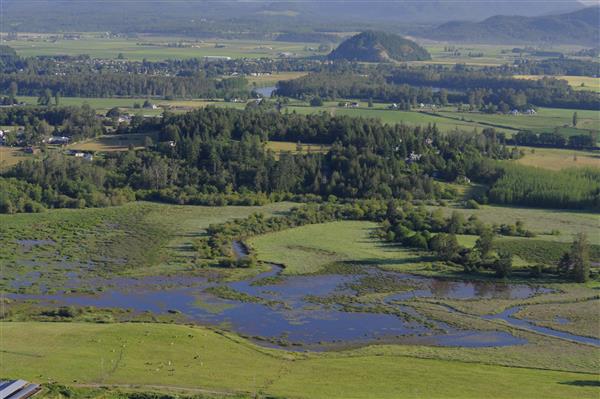
Keeping Barney Lake Remarkable
“That Trumpeter Swans were nearly extinct, and Barney Lake played a central role in the recovery of the largest swans in the world, is only one of the many remarkable things about Barney Lake,“ said Executive Director Molly Doran.
Faced with immediate and near-term opportunities to conserve the last parcels of undeveloped wetland and forest at Barney Lake, Skagit Land Trust launched the Barney Lake Futures Campaign to raise funds for land conservation acquisitions, habitat restoration efforts, and wildlife compatible viewing access.
“This conservation area is going to experience immense pressure in the years to come. There will be homes built right up to the edge of everything that is protected,” said Stewardship Director Regina Wandler. “It’s also a wonderful place for people to have experiences in nature, to sense some obligation to help protect places that these birds and animals need very badly.”
In the spring of 2022, Skagit Land Trust added ten acres of wetland to the 371 acres the Trust owns and manages at Barney Lake. In the fall of 2022, the Trust was able to raise funds to purchase five more acresof mature forest on the lake’s edge. The Trust also raised funds for future land purchases to buffer the wetland and provide educational viewing opportunities.
Barney Lake teems with wildlife. In the winter, the lake provides refuge for hundreds of migrating trumpeter swans and other waterfowl who rest and feed there overnight. Maturing forest near the wetlands provides great blue herons space to nest. Beavers work to expand and improve wetlands on the site. Barney Lake, Nookachamps and Trumpeter creeks, and other seasonal wetlands provide habitat for a wide array of songbirds, amphibians, plants, and wildlife.
The trumpeter swan conservation story speaks to how special Barney Lake is. At the turn of the 19th century, trumpeter swan numbers worldwide had plummeted to levels where extinction seemed imminent. Their down, soft skin, and beautiful feathers (used as pen quills) were prized. Lead shot added to their demise. Known mating pairs were deemed well below 100.
In the 1950’s a population of summer nesting and breeding trumpeters was discovered on the Copper River in Alaska. Hope for recovery grew. Researchers decided that to help swans recover, they had to know where they wintered so that their winter habitat could be conserved. And where did the first migrating swans returning to the lower 48 states end up? Barney Lake. Absent for almost 60 years, six majestic birds were found on the lake in the late 1950’s. Over 8,000 trumpeter swan now winter in Skagit County, which is the largest wintering population in the USA.
Yet, why Barney Lake? Barney Lake is a class I wetland. This type of wetland would be impossible to recreate within a human lifetime. Lying at the convergence of two forks of the Nookachamps, it is the largest remaining freshwater wetland in western Skagit County. The ‘Lake” consists of shallow emergent wetlands rich with plants that waterfowl love.
Juvenile salmon find refuge in its quiet waters during flood - and flood it does. The 160-acre lake easily grows to over 750 acres in wet winters. Trumpeters and other waterfowl need the undisturbed lake at night to rest, eat and sleep away from predators and humans. Trumpeters, with up to 10 ft wingspans, run across the water to take off. Trumpeter Swans need the long runway, and the expansive wetland Barney Lake offers.
It is no coincidence that the trumpeters have chosen an agricultural valley. 80% of wetlands in our area have been lost from centuries past. With trumpeters’ traditional wetland food sources greatly diminished, during the day we often see them foraging in farm fields to supplement their diet.
This top-class wildlife refuge is currently “hidden” by its geography, but it won’t remain that way.
“Barney Lake is on the edge of Mount Vernon. We know the city and communities will grow around it over time,” said Doran. “If we want this wetland to be there for wildlife, we must buffer Barney Lake while we still can, and we must educate the community about its importance. Barney Lake is a test case for how we can save places for wildlife and people on the edge of our cities”.
“It is important it is for us to find ways to connect people with Barney,” said Stacy Dahl, the Trust’s Volunteer & Education Programs Coordinator. “I've particularly liked bringing the Kulshan Creek Neighborhood Youth Program out here. We expose them to all of these great things that they see out here, but also get them thinking about why it’s important to conserve the wildlife and the places that are close to their home not only them, but their children, and the children after that.”
“Barney Lake is exactly the kind of place that we need Skagit Land Trust to protect. The swans and hundreds of waterfowl who come here to feed and rest, they are telling us this is an important place, and we need to pay attention to that,” said Trust board member Tim Manns.
Watch our new video on Barney Lake!